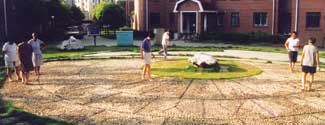
Cobblestone walking paths are common in China, where traditional medicine teaches that the uneven surface of the stones stimulate acupuncture points on the soles of the feet.

Behavioral researchers from the Oregon Research Institute investigated the health effects of cobblestones after observing people exercising and walking back and forth over traditional stone paths in China, and it turns out that the path to better health and lower blood pressure may be paved with cobblestones. When people over 60 walked on smooth, rounded cobblestones for just a half-hour a day over four months, they significantly lowered their blood pressure and improved their balance, a study showed.
Researchers expected to see some general improvement in health but also saw blood pressure drop measurably among the volunteers during the 16-week study, which was a dramatically short period of time. The researchers in Eugene simulated the rounded, river rock cobblestones with a specially designed mat that was 6 feet long and 1.5 feet wide. Some of the test subjects walked in their bare feet, others wore socks.
They were compared with a control group who simply walked for an hour, three times per week. Nearly all said they felt better after the exercise, but only the half who walked the cobblestones showed significant improvement in balance, measures of mobility and blood pressure. The practice is based on the theory that the pressure of the stones is much like acupuncture, suggesting that distant and unrelated areas of the body are linked together at certain points and can be stimulated to improve physical and mental health.
